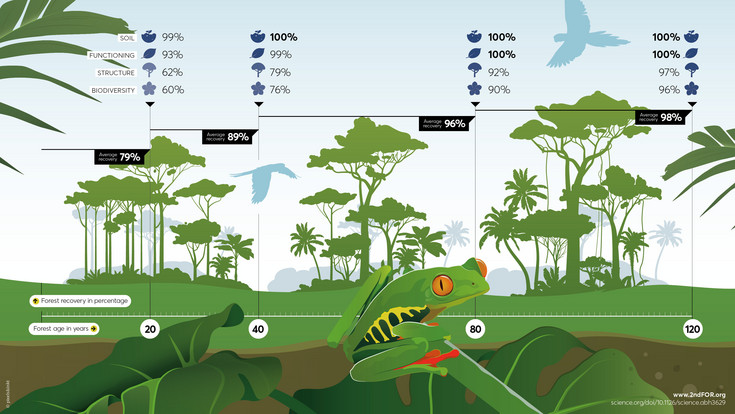10.12.2021 - SCIENCE study: Large short-term benefits of natural tropical forest restoration
Regrowing forests attain after 20 years nearly 80% of the fertility, carbon storage, and tree diversity of old-growth forests
Tropical forests are converted at an alarming rate through deforestation, but also have the potential to regrow naturally on abandoned lands. A study published this week in Science shows that regrowing tropical forests recover surprisingly fast, and can attain after 20 years nearly 80% of the soil fertility, carbon storage and tree diversity of old-growth forests. The study concludes that natural regeneration is a low-cost, nature-based solution for climate change mitigation, biodiversity conservation, and ecosystem restoration.
The international team of tropical ecologists analysed how 12 forest attributes recover during the natural process of forest regeneration, and how their recovery is interrelated using 77 landscapes and > 2200 forest plots across tropical America and West Africa.

Lead author, Professor Poorter from Wageningen University, the Netherlands says: “While it is essential to actively protect old-growth forests and stop further deforestation, tropical forests have the potential to regrow naturally in already deforested areas on abandoned lands. These regrowing forests cover vast areas, and can contribute to local and global targets for ecosystem restoration. They provide global benefits for climate change mitigation and adaptation and biodiversity conservation, and many other services for local people, such as water, fuel, wood, and non-timber forest products”.
He continues “These forests recover surprisingly fast, indicating that there are large short-term benefits of natural tropical forest restoration. Yet, the speed of recovery differs strongly across forest attributes: Recovery to 90% of old-growth forest values is fastest for soil fertility (less than 10 years) and for plant functioning (less than 25 years), intermediate for structure and species diversity (25-60 years), and slowest for aboveground biomass and species composition (more than 120 years).”
Second author, Dylan Craven, from Universidad Mayor in Chile says: “We analyzed how recovery of different forest attributes was interrelated. We found that maximum tree size, variation in forest structure, and tree species richness are robust indicators of recovery of multiple forest attributes. These three indicators are relatively easy to measure and can be used to monitor forest restoration. You can now already monitor tree size and variation over large areas and time scales, using remote sensing.”
Peter Hietz from the University of Natural Resources and Life Sciences and Florian Oberleitner (University of Innsbruck), who studied secondary forests in Costa Rica as part of his Master's thesis, also contributed to the international team. Hietz explains "It is still a common perception that tropical rainforests are lost forever once the trees are cut down. The published work clearly shows that this is not true and that in most cases regeneration can take place surprisingly quickly. However, it is not always so fast and now it is important to understand why some regenerate faster and others slower. In the forests of Costa Rica, for example, we have seen that this depends on the type of use and the soil. If we understand this better, we could protect forests that regenerate particularly poorly more strongly or also promote regeneration through targeted measures."
Last author, Bruno Hérault, from CIRAD, Ivory Coast explains: ”Given the local and global importance of secondary forests and their rapid recovery after 20 years, we encourage adoption of (assisted) natural regeneration as a low-cost, nature-based solution to meet the goals of the United Nations’ sustainable development, the UN decade of Ecosystem Restoration (2020-2030), UN framework on climate change mitigation (COP 26), and the Convention of Biological Diversity (COP 15)”. Hietz says: "There is no magic formula that fits all forests and areas, and a mix of natural processes and active measures may be needed. There is a range of options from natural and assisted regeneration, forest management or agroforestry. The optimal solution depends on the natural conditions, but also on the local population and their needs. By mixing different approaches, we can contribute to a near-natural and biodiverse landscape that also provides important ecosystem services."
For more information, please contact:
Prof. Dr. Peter Hietz
Universität für Bodenkultur Wien,
peter.hietz(at)boku.ac.at
Tel. +43 1-47654-83110
Prof. Dr. Lourens Poorter
Wageningen University and Research
Wageningen, Netherlands
Lourens.Poorter(at)wur.nl
Tel: +31 317 486216
Publication:
Lourens Poorter, Dylan Craven, Catarina C. Jakovac, Masha T. van der Sande, Lucy Amissah, Frans Bongers, Robin L. Chazdon, Caroline E. Farrior, Stephan Kambach, Jorge A. Meave, Rodrigo Muñoz, Natalia Norden, Nadja Rüger, Michiel van Breugel, Angélica María Almeyda Zambrano, Bienvenu Amani, José Luis Andrade, Pedro H.S. Brancalion, Eben N. Broadbent, Hubert de Foresta, Daisy H. Dent, Géraldine Derroire, Saara J. DeWalt, Juan M. Dupuy, Sandra M. Durán, Alfredo C. Fantini, Bryan Finegan, Alma Hernández-Jaramillo, José Luis Hernández-Stefanoni, Peter Hietz, André B. Junqueira, Justin Kassi N'dja, Susan G. Letcher, Madelon Lohbeck, René López-Camacho, Miguel Martínez-Ramos, Felipe P. L. Melo, Francisco Mora, Sandra C. Müller, Anny E. N'Guessan, Florian Oberleitner, Edgar Ortiz-Malavassi, Eduardo A. Pérez-García, Bruno X. Pinho, Daniel Piotto, Jennifer S. Powers, Susana Rodríguez-Buriticá, Danaë M.A. Rozendaal, Jorge Ruíz, Marcelo Tabarelli, Heitor Mancini Teixeira, Everardo Valadares de Sá Barretto Sampaio, Hans van der Wal, Pedro M. Villa, Geraldo W. Fernandes, Braulio A. Santos, José Aguilar-Cano, Jarcilene S. de Almeida-Cortez, Esteban Alvarez-Davila, Felipe Arreola-Villa, Patricia Balvanera, Justin M. Becknell, George A.L. Cabral, Carolina Castellanos-Castro, Ben H.J. de Jong, Jhon Edison Nieto, Mário M. Espírito-Santo, Maria C. Fandino, Hernando García, Daniel García-Villalobos, Jefferson S. Hall, Alvaro Idárraga, Jaider Jiménez-Montoya, Deborah Kennard, Erika Marín-Spiotta, Rita Mesquita, Yule R.F. Nunes, Susana Ochoa-Gaona, Marielos Peña-Claros, Nathalia Pérez-Cárdenas, Jorge Rodríguez-Velázquez, Lucía Sanaphre-Villanueva, Naomi B. Schwartz, Marc K. Steininger, Maria D.M. Veloso, Henricus F.M. Vester, Ima C.G. Vieira, G. Bruce Williamson, Kátia Zanini, Bruno Hérault. 2021.
Multi-dimensional tropical forest recovery. Science DOI: 10.1126/science.abh3629
Link to the article: science.org/doi/10.1126/science.abh3629
Photos: https://bokubox.boku.ac.at/index.php/#c7ee6d1d8203410e7814631118a031a5
